Second Battle of the Isonzo
On the night of 23 on 24 in May of 1915, Italian troops launched an offensive along the entire border, trying to seize the dominant positions, the heights that allowed them to reach the vital areas of the Austrian Empire. The full effect of surprise was not, as the Treaty of London was published, and in Vienna knew about the impending strike. However, the Austrians did not expect the enemy to go on the offensive until full completion of the mobilization and concentration of all forces. The Austrian command hoped that this delay would allow them to transfer troops from Galicia, from which the Russian army was retreating.
Thus, the Italians were able to achieve a partial surprise attack. In addition, the Italians had a large numerical advantage: about 800 thousand people against about 100-115 thousand Austrians. This allowed the Italian army to capture a number of important points, especially in the 1 th army offensive zone, including Tonale, Ponte Caffaro in the Val Judicaria, Monte Baldo, the slopes of Monte Lessini east of Lake Garda, Monte Carnot and Monte Foppiano, Monte Pazubio and Monte Buffelan (commanders on Vallarsa) and Pian delle Fugazze. Subsequently, during the Austrian offensive in the spring of 1916, some of these positions played a crucial role. Italian troops also captured the mountain passes in Cadore, located on the border and behind it.
In the upper course of the Isonzo River, Italian troops captured to the east of the river - Kaporetto, the heights of Monte Kozlyak, Monte Plec, Monte Liboussin and further to the south - the ridge between Yudria and Isonzo. The cities of Cormons, Versa and Cervignano were occupied without resistance. In the lower course of the Isonzo, a group of the 1 Cavalry Division and some other units under the command of General Verchellan should have taken the ferry across the river. The cavalry acted passively. This was partly due to the fact that the Austrians spread rumors that all roads and bridges are mined. Pieris bridge was really blown up, but on the whole it was misinformation. As a result, the Italians hesitated. The group commander for the error shifted.
After some regrouping of the 27 forces in May, the high command of the Italian army ordered the continuation of the offensive. The 1 Army Bruzati was able to capture a number of positions between the Val Lagarin Valley and the Azyago Plateau. However, in some cases, the Austrians put up stubborn resistance. In the Cadore Alps, the 4 Army also captured a number of positions and mountain passes. Several minor skirmishes occurred in the Carnic Alps. A strong battle was going on for Freykofel, which passed from hand to hand several times, until, finally, he was captured and retained by Italian troops.
The most serious operation of the 2 of the Italian army in the upper Isonzo was an offensive on Monte Nero. The Slémé and Mrzlé mountain ranges, located south of Monte Nero, were attacked for the first time between May 28 and June 4. However, the Italian attacks were unsuccessful. The Italian troops suffered heavy losses, storming the inaccessible Austrian positions. So, the 12 th regiment of the Bersaliers (selected shooters) lost a 400 man, not counting those who fell into the abyss. The commander of the regiment, Colonel de Rossi was seriously wounded, the commanders of both battalions were killed. The Modena Brigade lost more than 1200 people, the Salerno Brigade also suffered a lot. Italians were not able to capture the Mrzli mountain range, despite one-time attacks, and it became a serious threat until the battle of Caporetto. The Slemé array was the scene of fierce battles, the Italians and Austrians attacked each other.
A week later, the commander of the alpine units of the 2 Army, General Etna, decided to take the mountain of Monte Nero, the highest position in the army’s offensive zone. The Alpine units were ordered by small groups to get close to the enemy and "to win at all costs." On the night of June 16, the Italian Alpine Riflemen launched an assault on the Austrian positions. The 35-company of the Alpine shooters, under the command of Captain V. Varese, was able to quietly reach the enemy trenches and broke into the peak of 2138. After a fierce battle, the height was captured. After that, the Italians were able to capture another position at the peak of 2133. The 84 Company, supported by the 31 Company, after a fierce battle, was able to capture the highest peak in this array, 2246. In this case, the Italian troops managed to intercept and capture the Hungarian battalion, aimed at helping the garrisons positions. The Austrian troops counterattacked several times, trying to recapture the lost heights, but the Italians repulsed their attacks. The position remained for the Italian army before the battle of Caporetto. Thus, the Italian troops were able to seize the headwaters of the Isonzo river in order to be one of the main targets of the first offensive.
However, in order to achieve complete success, it was necessary to master the middle and lower course of the Isonzo River. And for this it was necessary to seize powerful bridgehead positions near Tolmino and Goritsy on the western bank of the Isonzo River. The Italian command decided to launch a powerful offensive from Plavy (south of Tolmino) to the sea. The 2 Corps under the command of General Reisoli was to force the Isonzo near Plavy and attack Sabotino. This blow was auxiliary and had to distract the enemy. In the meantime, Ruellet's 6 Corps was to strike Goritsa. The 11 and 7 corps attacked on the right flank and were given the task of seizing a bridgehead south of Goritsy.
The position of the Austrians at Plavy and Sabotino were very strong. At Plavy, the river flows through a narrow gorge, above which steep cliffs rise. The Austrians have created a strong defense here. 8 June Italians tried to build a pontoon bridge, but it was destroyed by the fire of the Austrian troops. On the night of June 10, a detachment from 200 man crossed the river in boats and captured the bridgehead. During the day, the Italians were able to hold their positions. The next night, the river was forced by two more battalions. The Italians attacked the height-dominating 383. But the Austrians went to the counter and threw the Italians. Then the Italians brought new troops across the river, and a fierce battle for this height was going on for a whole week. Only 12 June Italians 7 once attacked the deadly height. But the Austrian troops threw them with strong machine-gun fire and threw hand grenades. Only 17 June, troops of the 3 Division were able to capture the height of 383. Both sides suffered serious losses in this battle: the Italians - more than 2 thousand people, the Austrians - more than 2300 people. However, this success was local, as the captured bridgehead was extremely limited and filled with troops. It was necessary to expand the bridgehead.
The 6 offensive corps 8 and 9 June did not succeed. 10 Jun Italian command halted the offensive. The offensive of the 3 Army was somewhat more successful. The Italians could not force the river at Gradisc, but downstream they captured Monfalcone. In addition, to the east of the river, the Italians captured several more positions. But on the whole, there was not much progress on the Carso ridge. In the following days, skirmishes continued, but there were no serious battles.
Front of the 1 and 4 of the Italian armies in May 1915
The first battle of the Isonzo. Map Source: Villari L. The War on the Italian Front 1915-1918
Results of the first Italian offensive
By 16 June, the first offensive operation of the Italian army was finally completed. The results of the operation were modest. The Italians won, but their successes were small. The Italian army was able to achieve a small advance in the Trentino area, for a month of stubborn fighting, Italian troops captured the important height of Monte Nero, and a bridgehead across the Isonzo River in the Plavy area. The losses of the Italian army amounted to about 15 thousand people killed, wounded and captured, the total losses of the Austrian army - about 10 thousand people.
The plan for the sudden seizure of dominant heights and passes and a breakthrough to the vital areas of Austria-Hungary was not implemented. The Italian army was unable to realize partial surprise and numerical superiority. The Austro-Hungarian troops, without any problems, retreated to new pre-prepared lines of defense or held their positions, preventing the enemy from breaking into the operating room. This was mainly due to two factors. Firstly, the Austrians very intensively and with great skill, using the good opportunities provided by nature, created a powerful fortified barrier in the path of the Italian army, which relied on the Alps and the Isonzo River. Secondly, outnumbering the Austrians, the Italians were inferior to them in combat training and technical equipment (for example, there was a shortage of scissors to overcome the barbed wire). The shortage of artillery, including heavy, and ammunition to it, was particularly noticeable. Artillery was needed to destroy the strong fortifications of the enemy. The Italian infantry was mainly forced to crack the enemy defenses without artillery support. Played a role and the mistakes of the Italian command.
Italian Bersaliers
The Second Battle of the Isonzo
The high command of the Italian army decided to continue the offensive. The main blow was still inflicted on the Isonzo. After a ten-day break required to complete the mobilization and supply of fresh troops by sea, 23 June Italians again went on the attack. The Austrians in the same period continued to work to strengthen the defensive line. At the front of the 90 km on the Julian direction, the Italians deployed 19 divisions (about 250 thousand people) and 1200 guns. They were opposed by 13 Austrian divisions (about 78 thousand people) and 700 guns. The Italian commander Cadorna tried to take into account previous mistakes. Attention was paid to more thorough artillery preparation. But the lack of artillery shells, weapons and ammunition negated these efforts.
The battle on the site Tolmino and Podgora lasted several days. The Italians stormed the areas of Oslavia, Pouma and Podgora. Despite the fierce attacks of the Italians, and great losses, they failed to break through the strong Austrian defense. The bridgehead at Plavy was so overwhelmed with troops that the command of the 2 Army was forced to withdraw most of its forces, leaving only a sufficient garrison to defend this position. 29-30 June Italians attacked in the Sabotino area, but again unsuccessfully. July 5 Italian troops again attacked Podgora. Part of the Italian units were able to break through the first line of defense of the enemy, but they were mowed down with hurricane fire, and the remnants were knocked back by counter-attacks. On the coastal flank, the Italian troops acted more successfully and captured several enemy positions. But there was no decisive turning point in the battle. 7 July offensive was stopped.
Thus, the fights finally took a positional character. All Italian attacks were repelled by strong Austrian machine-gun fire. When the Italians penetrated the defense, the Austrians bravely went over to counterattacks and threw the enemy. The Italians did not have enough ammunition to destroy the enemy fortifications, lacked equipment. Due to heavy losses and a lack of reserves, the Italian attack was suspended.
After the 10-day pause, the Italians, pulling reserves and regrouping their forces (they created a three-fold advantage in the direction of the main attack), continued the offensive. 18 July Italian troops went on the attack. However, a big advantage in forces again did not help the Italian army. Weak Italian artillery could not make the passage in the wire fence, destroy the fortifications and suppress the enemy artillery. The offensive was conducted separately, without the normal interaction of infantry and artillery.
Heavy fighting went on in the area of Monte Nero - or rather, during the Isonzo. The points of Monte Rosso, Lemez and Smogar changed hands several times. As a result, the peaks were left for the Austrians. A similar picture was observed in the Podgora region. The persistent attacks of the Italian army, which suffered great losses by attacking the powerful positions of the enemy, did not lead to success. On the right (coastal) flank, the Italians were able to take the Doberdo Plateau, on this their successes ended. Due to the serious losses and the futility of the 3 August 1915 attacks, the offensive of the Italian army was halted.
The Second Battle of the Isonzo
Results
Thus, the second battle on the Isonzo did not bring significant results, despite the concentration of large forces and superiority over the Austrians in numbers. The Italian army achieved even less success than during the first offensive. The Italian front finally switched to a positional struggle. The Italians stuck and began digging. The losses of the parties have greatly increased. Total Italian losses exceeded 33 thousand people, Austrian losses were about the same.
As a result, the Italian army could not achieve a quick victory and capture the areas claimed by Rome. Austria-Hungary turned out to be a more serious opponent, as thought in Rome. True, in strategic terms, the opening of the Italian front helped the Russian Empire somewhat. The active operations of the Italian army eventually chained to the enemy’s 25 divisions, which were partially removed from the Serbian and Russian fronts. It was practically the only real help from the Western powers of the Russian army, which was bleeding and retreating under the powerful onslaught of the German-Austrian troops.
During August-September 1915, on the Italian front, there was a lull. Both sides actively built fortifications, consolidated in occupied positions. Only local collisions occurred. For example, the 4 Italian Corps was able to capture the entire Plestso area (or rather, the Isonzo). However, the attacks of the Italian troops in the same direction, on Jaworchek and Lipnik, were repulsed by the Austrians. The attacks of the Italian troops on the advanced fortifications of Tolmino - Santa Maria and Santa Lucia were repelled by the Austrian army.
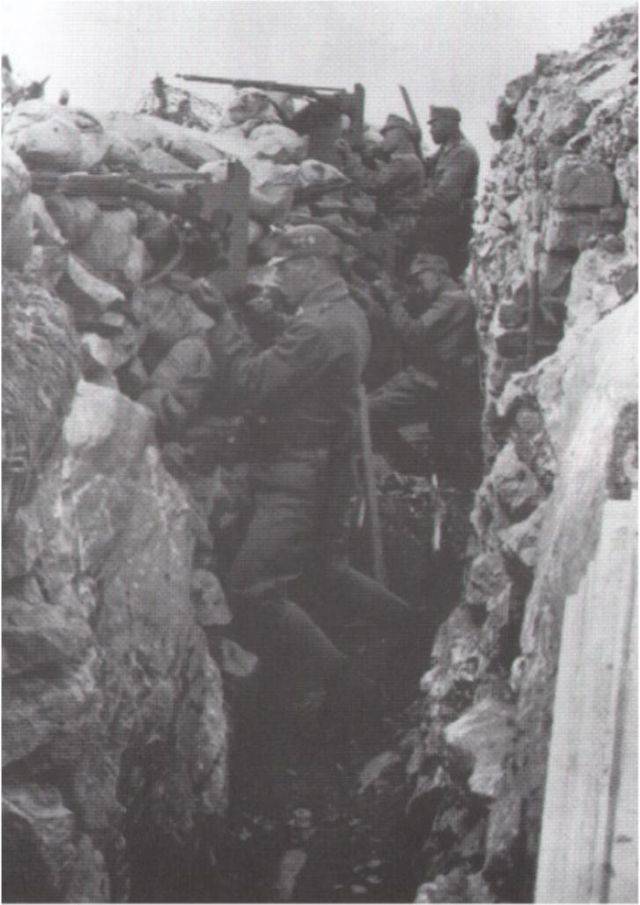
District Isonzo. Austro-Hungarian infantry in defense
- Alexander Samsonov
- 1915 Campaign
Military plans of the Entente and the Central Powers for 1915 year
Death of the 20 Russian Corps
"Rubber War" in the Carpathians
Battle for Prasnysh
Italian "jackal" enters the war
Battle of the Isonzo
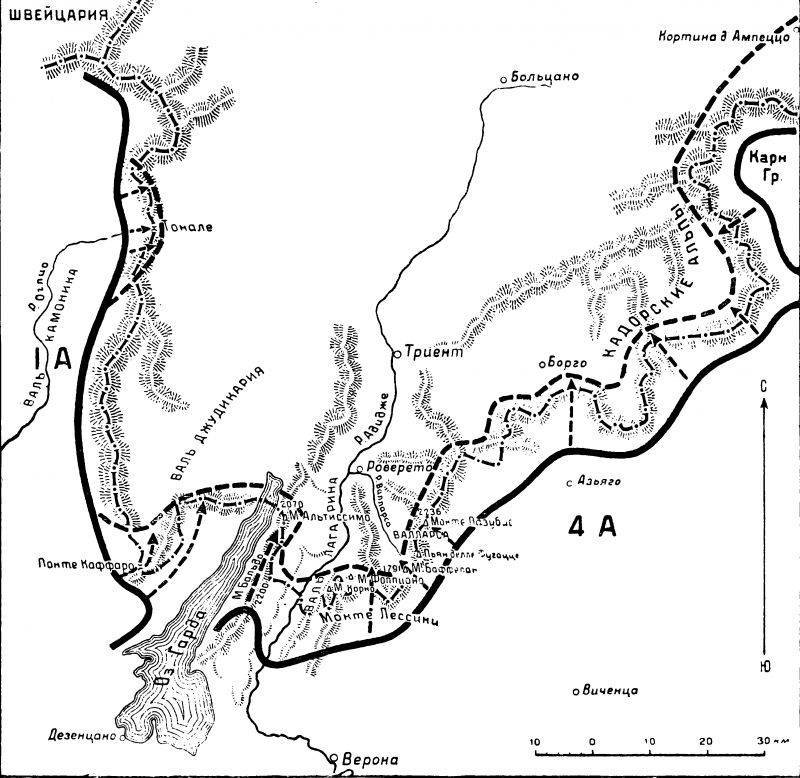
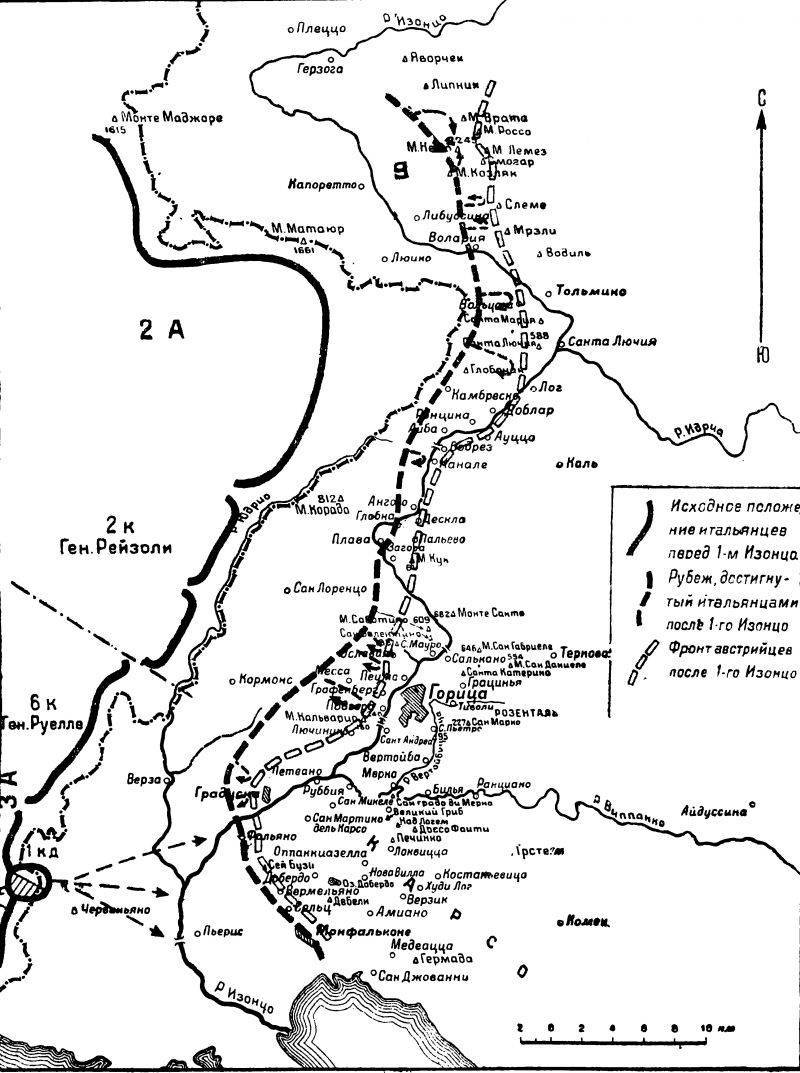
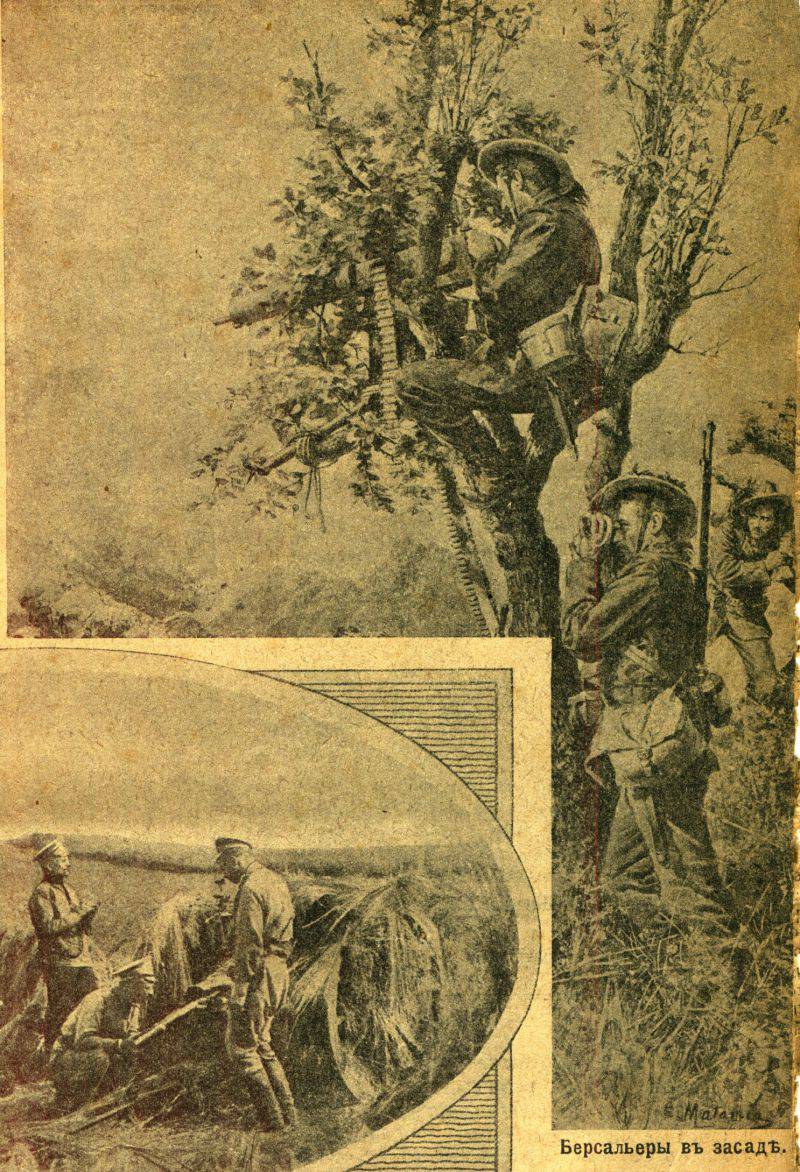
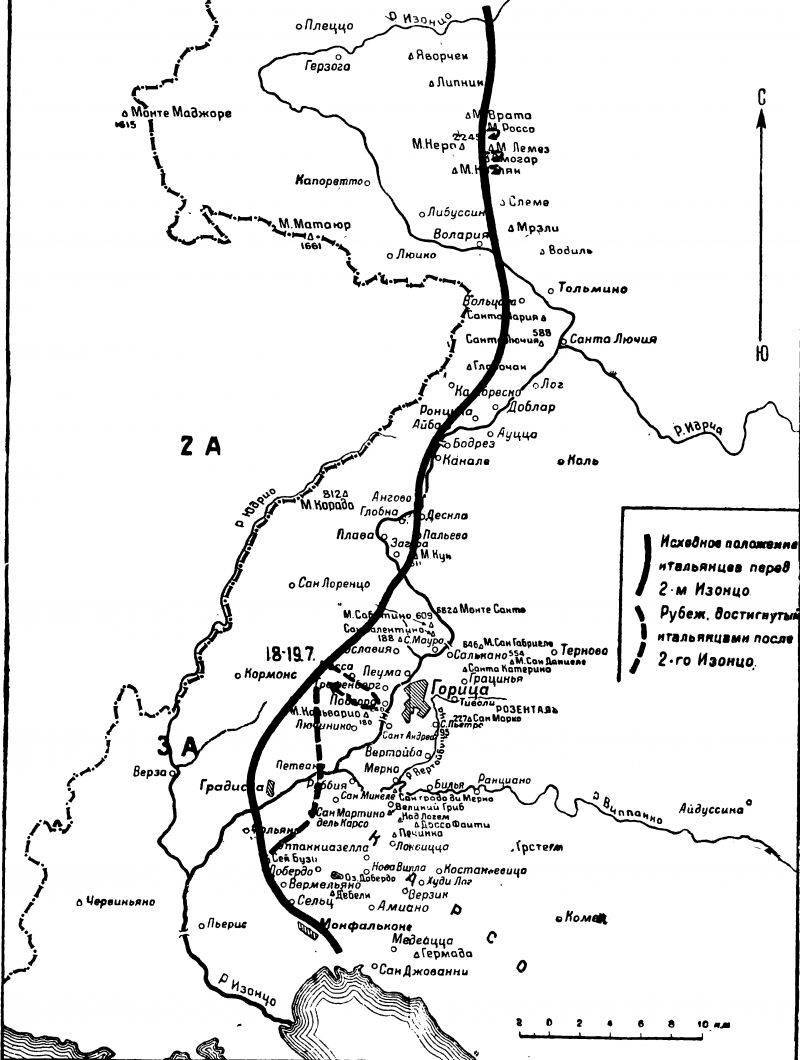
Information